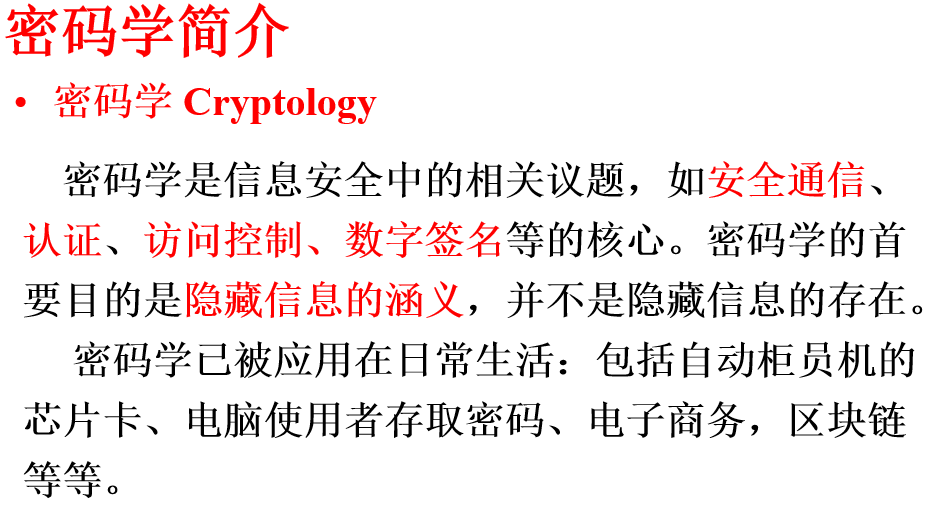《信息安全数学基础》教学大纲
课程代码 | 045100701 |
课程名称 | 信息安全数学基础 |
英文名称 | Mathematical Fundamentals for Information Security |
课程类别 | 专业基础课,选修课,其它选修课 |
课程性质 | 必修,选修 |
学时 | 总学时:48,实验学时:0,实习学时:0,其他学时:0 |
学分 | 3 |
开课学期 | 第三学期 |
开课单位 | 计算机科学与工程学院 |
适用专业 | 信息安全,网络工程,计算机科学与技术 |
授课语言 | 中文授课 |
先修课程 | 高等数学,线性代数与解析几何、离散数学、 |
课程对毕业要求的支撑 | 本课程对学生达到如下毕业要求有如下贡献: 1.工程知识:掌握扎实的基础知识、专业基本原理、方法和手段,能够将数学、自然科学、本专业基础知识和专业知识用于解决实际问题,并接触和掌握信息安全基础知识,为解决信息安全实际复杂问题打下知识基础。 2.问题分析:能够应用数学、自然科学、本专业基本原理、方法和手段和信息安全知识,识别、表达、并通过文献研究分析信息安全中的复杂问题,以获得有效结论。 3.设计/开发解决方案:能够设计针对信息安全复杂问题的解决方案,设计满足特定需求的信息安全系统,并能够在设计环节中体现创新意识,考虑安全、法律、文化等因素。 4.研究:能够基于科学原理并采用科学方法对信息安全复杂问题进行研究,包括设计信息安全环境、加密数据、并通过信息综合得到合理有效的结论。 5.使用现代工具:能够针对信息安全复杂问题,开发、选择与使用恰当的技术、现代信息技术工具,包括对信息安全复杂问题的预测与模拟,并能够理解其局限性。 |
课程目标 | 完成课程后,学生将具备以下能力: 本课程是信息安全专业的学科基础课,网络工程专业和计算机科学与技术专业也将该课程列为选修课。 信息安全是一门新兴的交叉学科,涉及通信学科、计算机学科、数学、物理、生物、法律和管理学科等多个学科,其核心技术是密码技术。而密码技术的基础是数学,主要是数论 , 代数和椭圆曲线论等数学理论。本课程结合信息安全和密码学的理论和工程实践,用严格的数学语言对信息安全和密码学所涉及的数学理论给出了详细的推理和说明,旨在提高学生的基本数学素养,培养学生的抽象思维能力,为学生以及从事信息安全工作的人打下坚实的理论基础,有助于跟上信息安全和密码学的最新进展,并提高创新能力和做出创新工作。 通过本门课程的学习,要求学生掌握数论、代数等方面的基础理论,包括欧几里得除法、模同余、欧拉定理、中国剩余定理、二次同余、原根、有限群、有限域、椭圆曲线等,掌握RSA和椭圆曲线等现代公钥密码体制和算法。 |
课程简介 | 信息安全是指信息系统(包括硬件、软件、数据、人、物理环境及其基础设施)受到保护,不受偶然的或者恶意的原因而遭到破坏、更改、泄露,系统连续可靠正常地运行,信息服务不中断,最终实现业务连续性。信息安全主要包括保证信息的保密性、真实性、完整性、未授权拷贝和所寄生系统的安全性。 《信息安全数学基础》是信息安全专业的必修课。目的是学习和掌握信息安全所涉及的数学理论,主要是数论、代数和计算复杂度等数学理论,特别是学会用严格的数学语言对信息安全和公钥密码体制所涉及的一些具体的数学理论给出了详细的推理和说明,对关键技术涉及的算法给出适合计算机实现的描述,从而跟上信息安全和密码学的最新进展,为从事相关的研究工作和工程实践奠定基础。 |
教学内容与学时分配 | 第一节课 思政教学 1学时 密码学是信息安全的重要基础之一,第一节课将根据密码学在国家政治、经济和民生中的重要作用讲解密码学的相关理论和发展过程,使学生了解密码学特别是现代公钥密码学在国家政治、经济和民生中的重要作用,让学生具有信息安全意识,了解本课程在信息安全中的重要作用
(一) 整数的可除性 8学时 整除的概念,欧几里得除法,最大公因数与广义欧几里得除法,素数算术基本定理,素数定理。 要求:掌握整除、素数、最大公因数等的定义,熟练运用欧几里得除法和广义欧几里得除法。 重点:最大公因数的定义、广义欧几里得除法。 (二) 同余 9学时 同余的概念及基本性质、剩余类及完全剩余系、简化剩余系与欧拉函数、欧拉定理、费马小定理、模重复平方计算法。 要求:掌握同余、剩余类、完全剩余系和简化剩余系等定义,熟练运用同余运算、欧拉定理、费马小定理以及模重复平方法。 RSA公钥密码系统的应用。 重点:完全剩余系和简化剩余系、欧拉定理、费马小定理、模重复平方法、RSA公钥密码系统。 (三) 同余式 8学时 一次同余式、中国剩余定理、高次同余式的解数及解法。 要求:掌握同余式等的定义,熟练运用中国剩余定理。 重点:一次同余式、中国剩余定理。 (四) 二次同余式与平方剩余 2学时 一般二次同余式、模为奇素数的平方剩余与平方非剩余、、 要求:掌握二次同余式和平方剩余等的定义。 重点:二次同余式和平方剩余。 (五) 原根与指标 2学时 原根、指数、指标等的定义及其基本性质、原根存在的条件。 要求:掌握原根、指数、指标等的定义。 重点:原根、指数、指标等的定义。 (六) 群 6学时 群、同态和同构、商群、循环群、有限生成交换群、置换群。 要求:掌握群、子群、有限群、循环群等的定义,熟练运用一些群的结构于信息安全和密码学。 重点:群的定义和性质。 (七) 环 4学时 环和同态、分式域、理想、多项式环。 要求:掌握环、的定义,熟练运用多项式环方面的一些结构于信息安全和密码学。 重点:环的定义。 (八) 域 4学时 域、有限域、扩域、 Galois 域等的定义,构造有限域、特征 2 的有限域。 要求:掌握域、有限域、扩域、 Galois 域等的定义,熟练运用域的构造方法构造有限域、特征 2 的有限域,特别是在信息安全和密码学中常应用的域。 重点:域的定义,有限域。 (九) 椭圆曲线 4学时 椭圆曲线基本概念、加法原理、有限域上的椭圆曲线。 要求:掌握有限域上椭圆曲线的构造,安全椭圆曲线的生成以及椭圆曲线密码的基本理论。 重点:椭圆曲线密码的基本理论。 |
实验教学(包括实验学时、实习学时、其他) | 无 |
教学方法 | 课程教学以课堂教学、课外作业、课外练习以及授课教师的科研积累等共同实施。 |
考核方式 | 本课程注重过程考核,考核形式、考核内容、课程目标、成绩比例为: (1)平时作业、课堂表现、课堂练习和课外练习(占总成绩的30%) 选做教材部分习题,考查学生对基础知识和基本理论的掌握和应用能力; (2)期末考试(闭卷)(占总成绩的70%) 采用笔试闭卷方式,考试内容选择教学内容所涉及的内容,重点考查基础知识、基本应用、运算能力; |
教材及参考书 | 现用教材:陈恭亮主编.信息安全数学基础. 清华大学出版社,2014年10月第2版 参考书: [1] 潘承洞等编著.简明初等数论. 北京大学出版社,1998 [2] 潘承洞等编著.初等数论. 北京大学出版社,1992 [3] 华罗庚著.数论导引. 科学出版社,1979 [4] 闵嗣鹤等编著.初等数论(第二版). 高等教育出版社,1982 [5] 张禾瑞,近世代数基础,人民教育出版社,1978。 |
制定人及制定时间 | 周杰,2019年4月11日 |
Course Code | 045100701 |
Course Title | Mathematical Fundamentals for Information Security |
Course Category | Disciplinary Basic Course |
Course Nature | Compulsory Course |
Class Hours | 48 |
Credits | 3 |
Semester | 3 |
Institute | School of Computer Science and Engineering |
ProgramOriented | Information Security, Network Engineering |
Teaching Language | Chinese |
Prerequisites | NO |
Student Outcomes (Special Training Ability) | 1. Engineering Knowledge: to solidly master the basic theories, knowledge, techniques and methods in information security discipline, with the ability to apply the knowledge of mathematics, natural science, engineering fundamentals and professional knowledge to solve the complex engineering problems, to master the methods and techniques in designing and developing the software and hardware in information security, to lay a good foundation to solve the complex problems in information security practice. 2. Problem Analysis: with the ability to identify, formulate and analyze the complex problems in information security engineering by using the basic principles in mathematics, natural science and engineering science to obtain the valid conclusions. 3. Designing and Developing Solutions: with the ability to design the solutions to complex and specific engineering problems in information security, to have an innovative sense in the design phase by considering the factors of society, health, safety, law and culture. 4. Research: with the ability to conduct investigations on the complex engineering problems based on scientific principles and adopting scientific methods, including the experiment designs, analyzing and interpretation of data, and to obtain valid conclusions by information synthesis. 5. Applying the Modern Tools: with the ability to develop, select and use the appropriate techniques, resources, and modern tools and IT tools, including prediction and simulation, to solve the complex engineering activities in information security and understand the limitations. 6. Engineering and Society: with the ability to reasonably analyze and evaluate the impacts of professional engineering practice and solutions to the complex engineering problems to society, health, safety, law and culture issues by using the background knowledge of information security engineering, to understand the consequent responsibility. 7. Environment and Sustainable Development: with the ability to understand and evaluate the impacts of professional solutions to the complex engineering problems in information security, to environment and societal sustainable development. 8. Professional Regulations: to understand the humanity science and have the sense of social responsibility, be able to responsibly understand and abide the professional ethics and regulations in engineering practice. 9. Individual and Team: to act as the team member or leader in the multi-discipline background teams. 10. Communication: with the ability to communicate effectively on the complex engineering problems with the engineering community and the public at large, such as composing the reports and documentation, preparing the presentations, clearly expressing and responding to instructions, to communicate in the cross-cultural contexts with the international perspective. 11. Project Management: to understand and master the principles in information security engineering management economic decision-making, and to apply them in the multi-disciplinary environments. 12. Lifelong Learning: with the sense of self learning and lifelong learning, and with the ability to continuously and adaptively learning. |
Teaching Objectives | After completing the course, students will have the following abilities: This course is the basic course of information security specialty. Network engineering specialty and computer science and technology specialty also include this course as an optional course. Information security is a new interdisciplinary subject, involving many disciplines such as communication, computer, mathematics, physics, biology, law and management. Its core technology is cryptography. The basis of cryptography technology is mathematics, mainly mathematical theories such as number theory, algebra and elliptic curve theory. This course combines the theory and engineering practice of information security and cryptography, and gives detailed reasoning and explanation of the mathematical theory involved in information security and Cryptography in strict mathematical language. The purpose of this course is to improve students'basic mathematical literacy, cultivate students' abstract thinking ability, lay a solid theoretical foundation for students and those engaged in information security work, and help them keep up with the letter. The latest developments in information security and cryptography, as well as improving innovative capabilities and making innovative work. Through the study of this course, students are required to master the basic theories of number theory and algebra, including Euclidean division, modular congruence, Euler theorem, Chinese remainder theorem, quadratic congruence, primitive root, finite group, finite field, elliptic curve and so on. They are also required to master modern public key cryptosystems and algorithms such as RSA and elliptic curve. |
Course Description | Information security means that information systems (including hardware, software, data, people, physical environment and their infrastructure) are protected from accidental or malicious reasons and are destroyed, altered and leaked. The system runs continuously and reliably, the information service is uninterrupted, and the business continuity is finally realized. Information security mainly includes ensuring the confidentiality, authenticity, integrity, unauthorized copy and the security of the parasitic system. Mathematical Basis of Information Security is a compulsory course for information security majors. The purpose is to learn and master the mathematical theories involved in information security, mainly the mathematical theories such as number theory, algebra and computational complexity. Especially, to learn to use strict mathematical language to give detailed reasoning and explanation of some specific mathematical theories involved in information security and public key cryptosystem, and to give a description of the algorithms involved in key technologies that are suitable for computer implementation. Keep up with the latest progress of information security and cryptography, and lay the foundation for related research work and engineering practice. |
Teaching Content and Class Hours Distribution | Class 1: Ideological and Political Education 1 Class Hours Cryptography is one of the important foundations of information security. In the first lesson, we will introduce the related theories and development process of cryptography according to the important role of cryptography in national politics, economy and people's livelihood, so that students can understand the important role of cryptography, especially modern public key cryptography in national politics, economy and people's livelihood, so that students can have information security awareness and understand the course's role in information security. The Important Role of the Whole (1) Divisibility of integers 8 Class Hours The concept of integral division, Euclidean division, maximum common factor and generalized Euclidean division, basic theorem of prime arithmetic, prime theorem. Requirements: Master the definitions of divisions, prime numbers and maximum common factors, and skillfully use Euclidean divisions and generalized Euclidean divisions. Emphasis: Definition of maximum common factor, generalized Euclidean division. (2) Remaining 9 Class Hours The concepts and basic properties of congruence, residue class and complete residue system, simplified residue system and Euler function, Euler theorem, Fermat's small theorem, modular repeated square method. Requirements: Master the definitions of congruence, residue class, complete residue system and simplified residue system, and skillfully use congruence operation, Euler theorem, Fermat's small theorem and modular repeated square method. Application of RSA Public Key Cryptosystem. Emphasis: Complete Residual System and Simplified Residual System, Euler Theorem, Fermat's Small Theorem, Modular Repetitive Square Method, RSA Public Key Cryptosystem. (3) Congruence 8 Class Hours First congruence formula, Chinese remainder theorem, solution number and solution method of higher congruence formula. Requirements: Master the definition of congruence formula and so on, and skillfully use the Chinese remainder theorem. Emphasis: First congruence formula and Chinese remainder theorem. (4) Quadratic Congruence Formula and Square Remaining 2 Class Hours Generally quadratic congruence, square residue and square non-residue of odd prime modulus,, Requirements: Master the definition of quadratic congruence and square residue. Emphasis: quadratic congruence and square residue. (5) Roots and Indicators 2 Class Hours The definition of primitive root, index, index, etc. and its basic properties, and the conditions for the existence of primitive root. Requirements: Master the definition of root, index, index, etc. Emphasis: Definition of root, index, index, etc. (6) Group 6 Class Hours Group, homomorphism and isomorphism, quotient group, cyclic group, finite generated commutative group, permutation group. Requirements: Master the definitions of group, subgroup, finite group and cyclic group, and skillfully use the structure of some groups in information security and cryptography. Emphasis: Definition and properties of groups. (7) Ring 4 Class Hours Rings and homomorphisms, fractional fields, ideals, polynomial rings. Requirements: Master the definition of rings, skillfully use some structures of polynomial rings in information security and cryptography. Emphasis: the definition of rings. (8) Field 4 Class Hours The definitions of domain, finite field, extended field and Galois field construct finite field and characteristic 2 finite field. Requirements: Master the definitions of domain, finite field, extended domain, Galois domain and so on, and skillfully use the method of domain construction to construct finite field and feature 2 finite field, especially in the fields commonly used in information security and cryptography. Emphasis: Definition of domain, finite field. (9) Elliptic curve 4 Class Hours Basic concepts of elliptic curve, additive principle, elliptic curve over finite field. Requirements: Master the construction of elliptic curves over finite fields, the generation of secure elliptic curves and the basic theory of elliptic curve cryptography. Emphasis: Basic theory of elliptic curve cryptography. |
Experimental Teaching | NO |
Teaching Method | Course teaching is implemented by classroom teaching, extra-curricular homework, extra-curricular exercises and teachers'scientific research accumulation. |
Examination Method | This course pays attention to process assessment. Examination form, content, goal and achievement ratio are as follows: (1) Peacetime homework, classroom performance, classroom exercises and extracurricular exercises (30% of the total score) Select some exercises in textbooks to test students'ability to master and apply basic knowledge and theories. (2) Final examination (closed examination) (70% of the total score) By using the closed-paper method of written examination, the examination content chooses the content involved in the teaching content, focusing on the basic knowledge, basic application and operation ability. |
Teaching Materials and Reference Books | Current Textbooks: Editor-in-Chief Chen Gongliang. Mathematical Basis of Information Security. Tsinghua University Press, October 2014, 2nd Edition Reference books: [1] Pan Chengdong et al. Concise elementary number theory. Peking University Press, 1998 [2] Pan Chengdong et al. elementary number theory. Peking University Press, 1992 [3] Hua Luogeng. Introduction to Number Theory. Science Press, 1979 [4] Min Sihe et al. elementary number theory (second edition). Higher Education Press, 1982 [5] Zhang Herui, Foundation of Modern Generations, People's Education Press, 1978. |
Prepared by Whom and When | Jie ZHOU, 11,April ,2019 |




